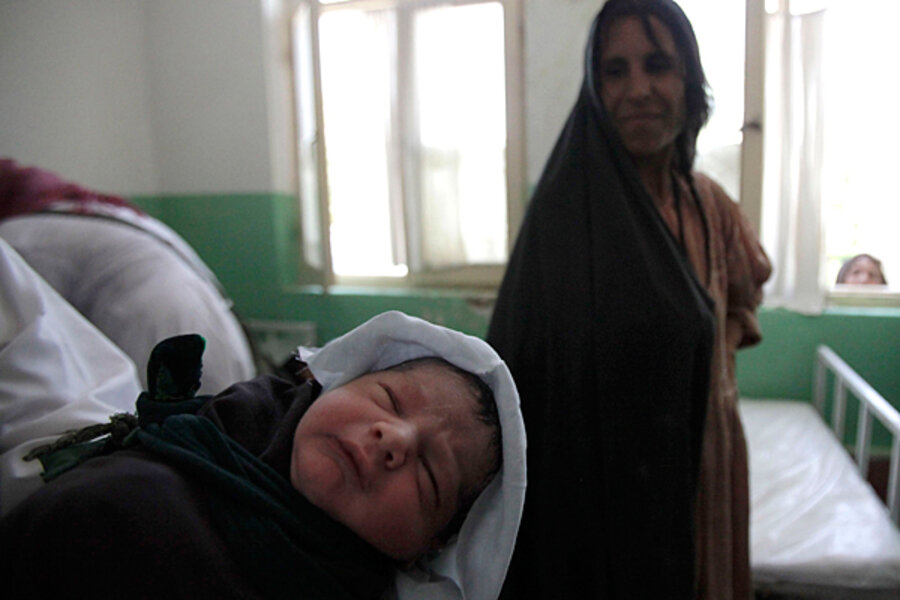Mother's Day: What are the best and worst countries for mothers?
Loading...
In Afghanistan, 1 in 11 women dies from pregnancy-related causes, compared with 1 in 7,600 in Norway, according to a study released just before Mother's Day by Save the Children.
Save the Children ranked the best and worst places in the world to be a mother. The rankings reveal stark disparities around the globe when it comes to child and maternal mortality, health care, and education.
As people celebrate Mother’s Day, the report offers grim reminders of the realities that many women face.
In the bottom 10 countries ranked by the report, 1 out of every 6 children dies before the age of five, 1 out of 30 women die of pregnancy-related causes, fewer than 50 percent of births have a skilled attendant, and 1 out of 3 children suffers from malnutrition. The US didn’t fare very well either, ranking 31st out of 43 developed countries.
But the report also offers some encouraging news. Over the past two decades, worldwide child deaths have decreased from 12 million to 8 million. And the report emphasizes the effectiveness of US aid in helping to improve the situation for both mothers and their children in developing countries.
“The work that we’re doing globally, funded by the US government, is making a difference,” says Mary Beth Powers, chief of Save the Children’s Child Survival Campaign, who says she’s worried that budget concerns threaten some of those investments.
US making a difference worldwide
Most encouraging, she says, is that the tools are already there to make a difference: Things like training front-line health care workers, for instance, to recognize and treat common childhood diseases, or investing in midwifery schools in developing countries, can improve statistics dramatically.
“The hopeful piece of this is that we do know what to do,” says Ms. Powers. “We’re not racing for a cure, we have the cures in hand.”
On Tuesday, the State Department announced a new initiative aimed at the world’s mothers – the Mobile Alliance for Maternal Action (MAMA). A partnership between the US Agency for International Development (USAID) and Johnson & Johnson, the alliance will focus initially on Bangladesh, India, and South Africa, and plans to harness growing mobile-phone networks and other technology to get more resources and information into the hands of expectant and new mothers.
“Women in developing countries, some of the women most at risk for pregnancy-related problems, will be able to use their cell phones to get health information via text messages or voice mails, and the information can even be customized for the stage of pregnancy or the age of their children,” said Secretary of State Hillary Rodham Clinton in announcing the initiative. She highlighted the improvements that other investments by the US and UNICEF have made in maternal and child health, contributing to a decline of 30 percent in maternal deaths in 19 countries.
“This is one example of where we can really trace US government efforts that have made a difference in the lives of women, babies, and children,” Secretary Clinton said.
But problems at home
While the Save the Children index paints a particularly grim picture for women and children in sub-Saharan Africa and other developing countries, it highlights problems for the US as well.
The US is down three spots from last year’s report, and behind countries like Croatia, Estonia, and Latvia.
One factor in America’s poor showing is its lifetime risk of maternal mortality – at 1 in 2,100, it’s the highest of any industrialized nation. In the US, a woman is more than 7 times as likely to die of pregnancy-related causes as a woman from Ireland, and 15 times more likely than a woman from Greece.
In addition, the under-5 mortality rate in the US is 8 out of 1,000 births – worse than 40 other countries. (In comparison, Norway’s rate is 3 out of 1,000 births.) The US also performed relatively poorly to other developed countries on indicators like preschool enrollment and maternal-leave policy.
“We aren’t making the investments that would improve childhood-mortality rates in this country,” says Powers. “Our government is considering cutting funding for preschool, and for underserved populations, and that’s where these pockets of deaths to mothers and children are happening, in impoverished communities.”
But the most striking picture that emerges from the report – and the rankings – are the vast discrepancies that exist for mothers and their children depending on where they live.
In Norway, at the top of the rankings, a typical woman lives to be 83 years old and has 18 years of formal education. Just 1 in 175 women will lose a child before he or she turns five, and nearly every woman has a skilled attendant when she gives birth.
In Afghanistan, at the bottom, only 14 percent of births have skilled attendants, and 1 child out of 5 dies before the age of 5 – meaning that almost every mother will suffer the loss of a child. The typical Afghani woman will die before she turns 45, and has fewer than five years of education.
“In Afghanistan,” notes Powers, “it is still more risky to give birth than ... fighting in Afghanistan.”






